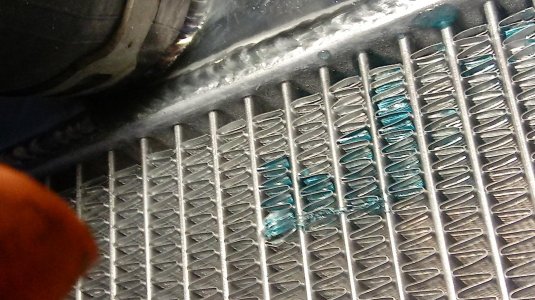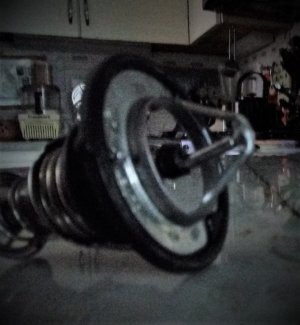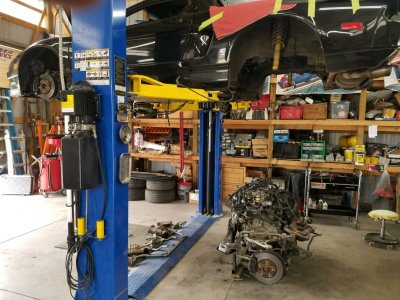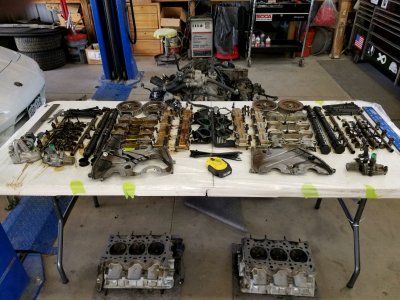Sounds like you are in good hands.
Based on dealing with several overheated NSX engines as well as same phenomenon you described,
would like sharing my experiences and one of the worst case that my friend dealt with.
Due to possibility of multiple issues and you don't want repeating the same tasks after placing everything back in place, would recommend proceeding step by step.
The thermostat
Never seen one stuck closed and being as the main cause of the overheating issue on any NSX engines.
So far, always stuck open on many of the original thermostat design.
After replacing to the new design one, seemed to be fine and no longer taking ages to warm the engine up.
If overheated or suddenly lost coolant, it's my own policy to replace the thermostat even if it was new.
Quite often, the excessive heat can generate lots of powder like residue in the cooling system and
it seems that thermostat doesn't like big thermal shock that requires the centre plunger to move quickly from full open to close.
I think your initial report of stuck closed thermostat is very likely to be the result of losing coolant suddenly due to cracked radiator and
thermostat exposed to excessive heat but suddenly cooled down as no more contact to the coolant.
Once closed, no longer functioning.
Not the direct factor causing the overheating.
The radiator
Mentioned the following so many times on the NSXCB forum.
The OEM radiator is just another consumable parts, just like the oil filter but at much longer service interval.
One of the most neglected service on any car make/model.
I replaced so many NSX radiators in the past and even replacing one for another owner at the moment.
All of them were seeping the coolant slowly without being noticed by the owner because the coolant tends to crystallise and won't drip on the floor once the water has evaporated.
Also, by now, almost all of the original ones are no longer holding the original cooling efficiency.
Not a big problem on 3.0L C30A engine on street driving condition but the owners of 3.2L C32B engine or those driving hard should pay much more attention.
Depending on the shape of the circuit or the driving environment, in hot summer, 1 timed lap would force you to take cooldown lap next even without any engine power modifications.
The knock sensor
If doing the head gasket job, please take a look at the plastic holder of the knock sensor cable after removing the intake manifold.
If overheated or driven really hard all the time, almost always the plastic holder was melted.
Melted holder itself is not a big issue but please double check that the cable sleeve/insulator is not hardened or the cable itself is not damaged (will trigger CEL).
By the way, never touch the knock sensor itself unless 100% you have to.
Not even try removing the sensor connector.
It seems that being placed within the V-bank, they (one for each bank) are exposed to high temperature resulting in fragile plastic/metal bonding at the sensor body.
If you touch the sensor or even try disconnecting the wire connector, very likely the sensor body will split at the seam of the green plastic connector and the metal piezo sensor body.
If you ask S2000 owners about the knock sensor, they will know what I'm talking about.
They are designed for the specific resonance frequency window so OEM one is quite expensive.
If overheated and doing H.G., you may want considering replacing them anyway if never replaced in the past.
Though, you can wait for the CEL and replace them later by just removing the intake manifold.
Good Fuel mixture
As you can't even fireup the engine, will leave the feedback software loop out of scope.
On fireup, there is specific map mainly based on the coolant temp for the INJ timer.
Adjustment for RPM/voltage/etc applied and triggered at specific crank angle fuel/IG timing.
You have confirmed that the fuel pump resistor is not the cause.
The phenomenon you mentioned was experienced by many owners and even helped road rescue people while one owner was stranded on the way to his holiday
so was hoping the same on yours.
I would check the fuel pressure at this stage.
You don't even need cranking the engine for this.
Proper gauge would be best but I know many owners used the cheap one from ebay/amazon/etc successfully for the quick testing purpose.
It's the one that can be mounted directly on top of the fuel filter banjo.
Personally, I won't install it as permanent solution but for a quick check, good enough.
Just ask someone to turn the IGSW into P2 On then back to P1 ACC and repeat it several times to prime the fuel system while checking the pressure gauge.
As mentioned above, on fireup, ECU uses coolant temperature based map.
The sensor in use is called TW sensor.
This is different from other 2 coolant related sensors (Sender unit for the temperature gauge and the Rad fan sensor for the fan control unit).
It's the one located at the front bank with black connector sleeve, below EGR valve.
On several NSX engines, this sensor failed and sent cold temperature data forcing ECU to use very rich mixture.
Some owners experienced hard time starting the engine (but at least, was able to fire up so probably not the case on yours).
If this sensor fails (and if you manage to start the engine), the engine will never goes to the idle window and stays higher at about 1,000+ rpm even when the engine has fully warmed up.
As mentioned, probably not related to your case but since you overheated the engine, worth checking the sensor output at room temperature as it's located in quite difficult to access area.
Not easily replaced with the engine inside the engine bay.
Did you read the error code even if you didn't see the CEL?
Could be too late as you may have already disconnected the battery but there are multiple error codes that won't trigger the CEL but stored in the memory
unless failure condition detected twice within the same drive cycle or in consecutive cycles.
If the engine was cooked to the point you can't even fireup again, you may have stored some error codes at the time you first overheated the engine massively.
I do hope your CRK/CYL sensor is still healthy.
Not just fuelling related but when you were about to park the car after test driving with the new replacement radiator, did you notice lots of smoke or awful smell of exh fume?
Good Spark
Have you inspected the spark plugs?
It's almost impossible to fail all spark plugs and IG coils at the same time so not the direct cause but may support you in diagnosis.
On almost all of the engines that required head gasket job, would notice some unusual deposit left on the centre terminal/insulator area of the plug especially at the cyl where the head gasket was breached.
Also, at the same cyl, the very spark plug would smell really-really awful.
Can't describe it well but it's like you don't want keep smelling it for more than 5sec.
Almost like choking yourself.
It was like the smell of Qualify session special fuel used by the Ferrari F1 team in 80s'….
Normally, it would result in multiple misfire and very rare not being able to fireup at all (like yours) but some owners ended up not being able to fireup when their ignitor module failed.
Heat soaking can trigger this failure mode but since you parked the car overnight and then tried fireup so probably not the case but worth keeping in mind.
Good Compression
Hope you double checked that it was safe to fireup.
On many engines with the head gasket issue, the owners didn't even notice it and were able to keep driving without temperature issue under street driving condition.
They only noticed it when driven hard through mountain road and noticed that the coolant was pushed out from the tank overflow tube.
They managed to keep driving without any further loss of coolant or no abnormal temperature noticed while driving on the motorway or city driving.
If your engine is so bad to the point even not being able to fireup, then DO NOT carry out the compression check even on the cold engine.
Instead, use the leakdown test but on the cold engine.
If the engine is so bad, it would result in big leakage and should be able to hear the hissing sound through the oil level dip stick pipe, etc.
Followings are what my friend dealt with.
Hope yours is not that bad.....
On one engine, the owner lost coolant on motorway/freeway with cracked radiator lower tank and it even partially locked the WP and let the TB to jump the teeth.
This was very rare case because my friend found out that the owner previously experienced overhearing situation with the coolant pushed out from the tank overflow tube few years ago but
no further temperature issue noticed so left it without doing anything.
Kept driving with no further loss of coolant since then.
Similar to what I mentioned above with the owners that didn't notice their head gasket issue.
With this NSX, the WP was still the original design so never replaced since leaving the factory.
Who knows what effect the first overheating had over that ancient WP.
Honda changed the design because there were reports of seeped coolant landing on the TB rib.
This time, the owner was not so lucky and the damages were massive.
At the end, the owner decided to swap the engine and even added some upgrades.
If you didn't see lots of smoke, no nasty exhaust fume and the spark plug didn't smell awful, then hope the potential damages are limited and other factors are preventing you from firing up the engine.
Kaz










